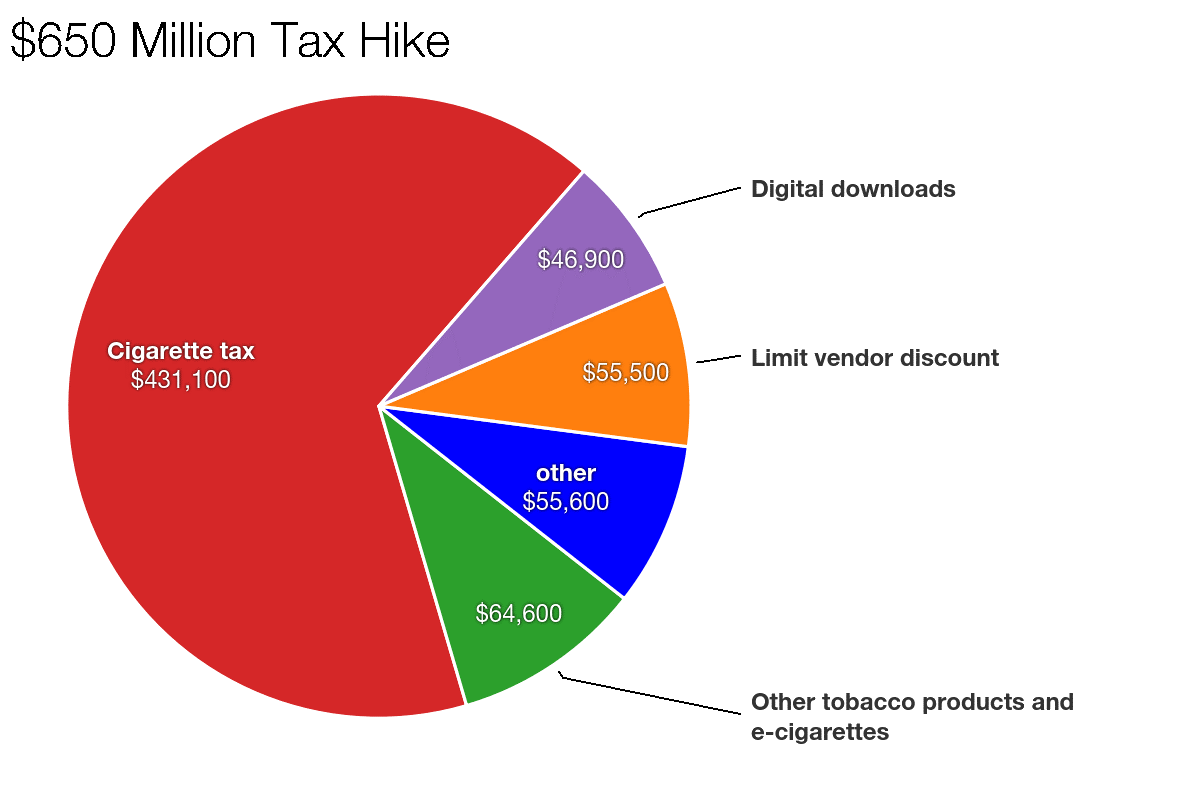On June 30, the legislature passed a $31.6 billion General Fund Budget. Gov. Wolf allowed this budget to become law without his signature on July 12. On July 13, the House and Senate passed a revenue package to pay for the spending plan.
Here is what you need to know about the budget.
The Good
- Spends less than Gov. Wolf proposal. The $33.3 billion budget Gov. Wolf outlined was never seriously considered, given how far it was outside the realm of political possibility. Still, this budget spends $1.7 billion less than what Gov. Wolf offered.
- No income or sales tax increases. The tax package does not include the income or sales tax increases Gov. Wolf proposed in his February budget address. A tax on home heating bills was left out of the revenue package as well. The overall tax increase of $650 million is about one-fourth of the $2.7 billion tax hike Gov. Wolf wanted.
The enacted tax increases amount to $203 per family of four, borne mostly by smokers. Wolf’s proposed budget called for a tax increase of $850 per family of four.
- Expansion of school choice. The legislature increased the Educational Improvement Tax Credit (EITC) by $25 million. The EITC provides tens of thousands of private school scholarships to students in need. The state will now offer $75 million in tax credits for K-12 scholarships, $37.5 million for educational improvement organizations, and $12.5 million for pre-K scholarships, plus $50 million for the Opportunity Scholarship Tax Credit (OSTC) program.
The Bad
- Spending growth is 5 times the rate of inflation and population growth. The $1.6 billion increase represents a 5 percent increase in a year when inflation is less than 1 percent. This represents the biggest spending increase in a decade. The General Fund has now grown by $2.5 billion in Gov. Wolf’s first two years, approaching the $2.85 billion General Fund increase passed during the prior eight years.
- $650 million tax increase. The $1 per pack cigarette tax hike makes up the bulk of the new revenue. This tax is an unreliable revenue source, would disproportionately harm the poor and do little to dramatically reduce the number of smokers in Pennsylvania. The tax could potentially hit 2 million adult smokers in the state.
The revenue package includes eight additional tax increases:
- A new 55-cents-per-ounce tax on smokeless tobacco and a 56-cents-per-ounce tax on roll-your-own cigarettes.
- A 40 percent tax on the wholesale price of e-cigarettes
- A 6 percent sales tax on digital downloads, including videos, books, games, music, and applications.
- An increase in the bank shares tax.
- A reduction in the “vendor discount” offered to retail stores who collect sales taxes for the state.
- A 2 percentage point tax increase on casinos’ revenue from table games.
- An income tax on lottery winnings.

 Biggest spending increase in a decade. The $1.6 billion increase in spending over the enacted budget represents the largest year-over-year increase since 2006-07. (The budget also includes $90 million in “supplemental appropriations” to be spent as part of the 2015-16 budget).
Biggest spending increase in a decade. The $1.6 billion increase in spending over the enacted budget represents the largest year-over-year increase since 2006-07. (The budget also includes $90 million in “supplemental appropriations” to be spent as part of the 2015-16 budget).
- The budget remains unbalanced. The budget counts on $200 million in loans from other funds, and relies on $100 million from expanding online gambling—legislation that hasn’t passed the legislature yet.
Pennsylvania's Constitution does not say the legislature can pass something pretty close to a balanced budget or a promise to balance the budget in the near future. It requires a balanced budget.
- Risks a future tax increase. Revenues from sin taxes—which this budget relies upon—are unpredictable and decline over time. The budget also relies upon one-time revenue sources including tax amnesty, the aforementioned $200 million loan, $90 million in transfers from other funds, and aspects of gaming expansion and wine reform.
In addition to the short-term fixes above, the budget authorizes the Department of Human Services to take money from the Workmen’s Compensation Trust Fund if Medicaid bills exceed appropriations. All of these provisions set up at a potential income or sales tax increase next year to bridge the budget gap. - Other issues tabled until the fall. Pension reform and charter school reform, two issues debated closely as part of this budget negotiation, were not addressed. Lawmakers indicated they plan to address these issues this fall—though such promises often never come to fruition.
- Does not include vital spending reforms. Lawmakers did not address the $800 million in corporate welfare identified in the budget. Nor did they tackle reforms to slow the unsustainable growth of human services spending.
Where is the new spending going?
- Community and Economic Development – $13 million (5.8% increase).
- Conservation and Natural Resources – $45 million (72% increase). This increase stems from Gov. Wolf’s decision to bar gas extraction under state lands, shorting the Oil & Gas Fund and leaving taxpayers to foot the bill.
- Corrections – $153 million (6.8% increase).
- K-12 education – $666 million (6% increase). This includes $345 million for school pensions, $200 million for basic education, $25 million for government-run preschool, and $20 million for special education.
- Human Services (formerly Public Welfare) – $466 million (4.1% increase).
- $18 million more for the General Assembly.
- $38 million more for higher education.
RELATED : TAXES & SPENDING, PENNSYLVANIA STATE BUDGET, TAX REFORM

